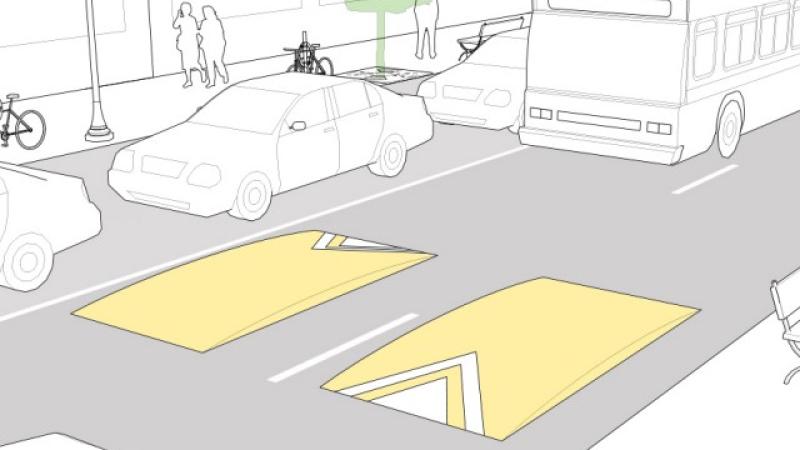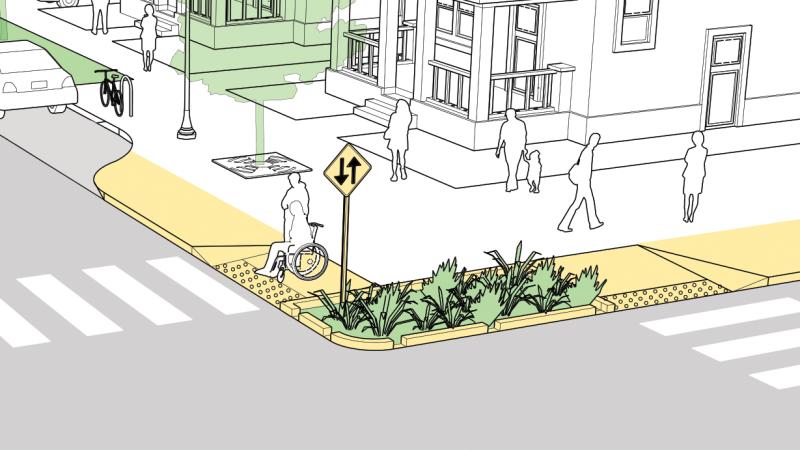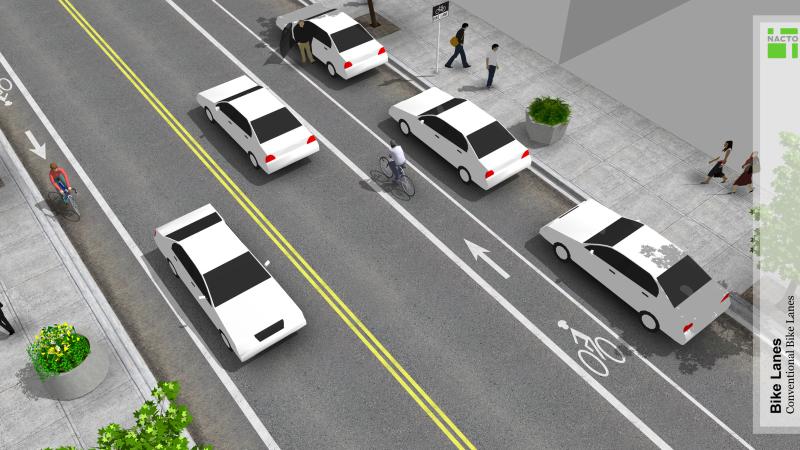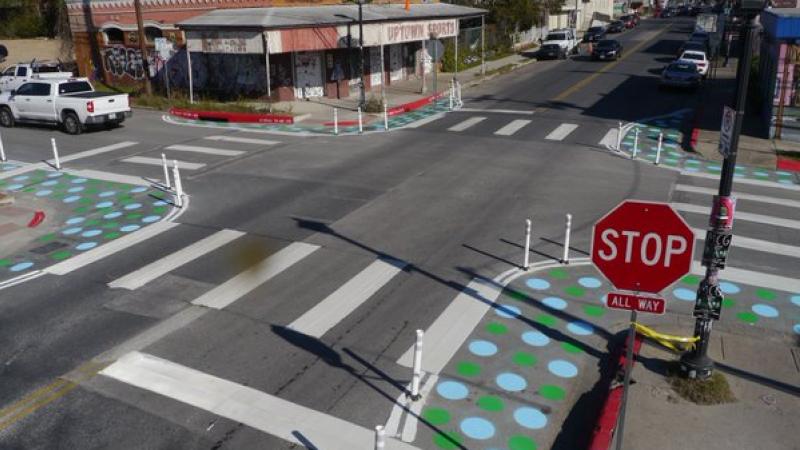Neighborhood Transportation Improvements Program
Note: The City has updated its traffic calming program with a new process and application. Please review the details below. If you have an urgent request, please submit it through Alex311.
About the Program
The Neighborhood Transportation Improvements Program (NTIP) is a resident-driven program that provides street improvements that make it easier and safer for people to travel by foot, bike, or car in Alexandria neighborhoods and create a sense of place. Residents may petition the City to address neighborhood transportation issues such as limited crossing opportunities, unsafe vehicle speeds, challenging intersections, and more.
This program is part of the City’s Complete Streets Program to create a safe transportation system that supports people of all modes, ages, and abilities.
Potential Treatments

Crosswalks

Daylighting
Daylighting improves visibility at intersections or other crossings by removing parking and/or installing curb extensions.

Speed Cushions
Speed cushions slow down vehicles where slow speeds are desired.

Curb Extensions
Curb extensions reduce crossing distance, reduce turning speeds, improve visibility, and provide more sidewalk space for ramps or other amenities.

Medians
Medians provide a refuge space for pedestrians crossing the street, slow vehicle speeds, and create space for landscaping.

Chicanes
Chicanes create a lateral shift in the roadway, using strategic on-street parking or curbing, to slow vehicle speeds.

Neighborhood Traffic Circles
Neighborhood traffic circles reduce vehicle speeds at intersections, can replace all-way stops when compliance is low, and can be helpful on designated bike routes.

Pinchpoints
Neckdowns narrow the roadway to reduce vehicle speeds.

Bike Lanes
Bike lanes provide dedicated space for people biking or scooting, narrow the roadway, and reduce vehicle speeds.

Stop Signs
Stop signs help manage the flow of traffic at intersections, but are not intended to be used as a traffic calming device.

Enhanced Signs
Enhanced signage at key locations can improve safety.

Tactical Treatments
Tactical improvements, such as painted curb extensions, can provide most of the benefit of traditional traffic calming treatments within a shorter timeframe at a fraction of the cost. The City is also working to align these types of treatments with the public art efforts.
Eligibility Criteria
Tier 1 Criteria
Applicants must meet the criteria below in order for their application to be considered:
Criteria |
Eligible |
Ineligible |
|---|---|---|
|
Street Classification |
Local
|
Major Collector |
|
Ownership |
Public |
Private |
|
Street Width |
One-way streets with travel lanes >9’ |
One-way streets with travel lanes <9’ |
|
Street Length |
Streets >900’ long |
Streets <900’ long or are a dead-end |
|
Scope of Request |
Holistic neighborhood improvements (i.e. multiple treatments at a series of locations) |
Spot treatments at a single location |
|
Past Requests |
A similar request has not been considered in the last 3 years. |
A similar request has been considered in the last 3 years. |
|
Related Projects |
An existing City project is not underway in the subject area. |
An existing City project is underway in the subject area. |
Tier 2 Criteria
After an application is submitted for an eligible street, the City will evaluate the application and may collect data. Streets must meet the following criteria for their application to be considered further.
Criteria |
Eligible |
Ineligible |
|---|---|---|
|
Vehicle Volumes |
Local streets: ≥500 vehicles per day Minor collector streets: ≥1,500 vehicles per day |
Local streets: <500 vehicles per day Minor collector streets: <1,500 vehicles per day |
|
Vehicle Speeds |
85th percentile speed ≥5 MPH over the posted speed limit in at least one direction |
85th percentile speed <5MPH over the posted speed limit in both directions |
Application Process
Submitting an Application
Before completing an application, talk to your neighbors. NTIP is a resident-driven program that requires majority neighborhood consensus for a project to occur. Ensure that you and most of your neighbors are in general agreement on the issues you would like the City to help solve.
Applicants are required to provide signatures from at least five neighboring households in the proposed project area to demonstrate preliminary support for the project. Alternatively, applicants may receive endorsement from their condo association, homeowners association, property manager, civic association, or similar neighborhood representative in lieu of the 5-household signature requirement.
Timeline
Applications are due by December 31 each calendar year. Applications are reviewed annually between January-June, which includes preliminary screening, data collection, evaluation, and budgeting. Applications that are selected to proceed will be programmed into the following fiscal year’s budget and work plan.
For example, an application submitted in October 2024 will be evaluated between January-June 2025. If it is approved, it will be programmed into the budget and work plan for Fiscal Year 2026 (July 2025-June 2026).
Note that emergency requests should not be submitted through this program, but instead should be submitted through Alex311 for a more immediate response.
Application Evaluation
Due to available resources, the City cannot approve all requests it receives. Therefore, the City evaluates all applications based on a variety of factors to prioritize applications based on need to ensure effective use of public resources. Factors include, but are not limited to:
- Crash history and/or risk
- Vehicle volumes
- Vehicle speeds
- Proximity to schools, parks, recreation centers, libraries, or transit
- Geographic and social equity
If Your Application Is Selected
If your application is selected, the applicant or their designee will be the assigned “Project Champion”. The Project Champion will have the following responsibilities during the life of the project:
- Liaise with the neighborhood, share information, collect feedback, and generate support for the project (60% required)
- Coordinate with City staff on project design
- Attend a Traffic & Parking Board Public Hearing (virtual or in-person), if applicable, to voice support for proposed improvements.
Neighborhood support is required to advance the project. For single-family neighborhoods, 60% of the households must indicate support or neutrality for the project. Alternatively, support from the representative civic association may be considered. For multi-family neighborhoods, support from an association board or property manager is sufficient.
If there is not sufficient neighborhood support to advance the project, the project will be terminated, and the application will return to the application pool for a period of 3 years. This is to ensure other applicants also seeking improvements on their street have the opportunity to participate in the program.
If Your Application is Not Selected
If your application is not selected, it will remain in the pool of applications for 3 years. After 3 years, if the application has not been selected for approval, it will no longer be considered. A new application may be submitted after an additional 3 years.
Projects
Current Projects
Taney Avenue Traffic Calming
Parkfairfax Traffic Calming
Cameron Mills Road Traffic Calming
South Jordan Street Improvements
Additional Resources
Visit the resources below to learn more: